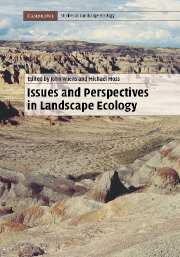Book contents
- Frontmatter
- Contents
- List of contributors
- Preface
- PART I Introductory perspectives
- PART II Theory, experiments, and models in landscape ecology
- PART III Landscape patterns
- PART IV Landscape dynamics on multiple scales
- PART V Applications of landscape ecology
- PART VI Cultural perspectives and landscape planning
- PART VII Retrospect and prospect
- 32 The land unit as a black box: a Pandora's box?
- 33 Toward a transdisciplinary landscape science
- 34 Toward fostering recognition of landscape ecology
- 35 Toward a unified landscape ecology
- Index
- Plate section
- References
35 - Toward a unified landscape ecology
from PART VII - Retrospect and prospect
Published online by Cambridge University Press: 20 November 2009
- Frontmatter
- Contents
- List of contributors
- Preface
- PART I Introductory perspectives
- PART II Theory, experiments, and models in landscape ecology
- PART III Landscape patterns
- PART IV Landscape dynamics on multiple scales
- PART V Applications of landscape ecology
- PART VI Cultural perspectives and landscape planning
- PART VII Retrospect and prospect
- 32 The land unit as a black box: a Pandora's box?
- 33 Toward a transdisciplinary landscape science
- 34 Toward fostering recognition of landscape ecology
- 35 Toward a unified landscape ecology
- Index
- Plate section
- References
Summary
The variety of topics and approaches represented by the essays in this volume testifies to the diversity of landscape ecology as a discipline. Remote sensing, fragmentation, ecological networks and greenways, percolation models, spatial statistics, cultural perceptions, metapopulation dynamics, land-use planning, experimental model systems, watershed hydrology, individual-based modeling – landscape ecology is all of these, and more.
This diversity is at once the great strength and the potential weakness of landscape ecology. Landscape ecology can gain strength from the sharing of problems, perspectives, and procedures that are derived from different research traditions and cultures. “Interdisciplinary” has become a fashionable label, and while many interdisciplinary approaches are simply traditional disciplines dressed in new clothes, landscape ecology truly is interdisciplinary. It is this convergence of different avenues of thought and practice that gives landscape ecology its tremendous vitality and that offers the promise of new insights into the ecology of land (and water; see Wiens, 2002) systems. But this diversity also carries with it the threat of fragmentation and polarization. As landscape ecology continues its explosive growth, there is a risk that subdisciplines will seek their own identity and will look inward rather than outward, splintering rather than consolidating landscape ecology.
If landscape ecology is to contribute meaningfully in such arenas as the resolution of land-use issues, the emergence of comprehensive conservation initiatives, or the development of spatially sensitive ecological theory, it must become conceptually and operationally unified.
- Type
- Chapter
- Information
- Issues and Perspectives in Landscape Ecology , pp. 365 - 373Publisher: Cambridge University PressPrint publication year: 2005
References
- 9
- Cited by

